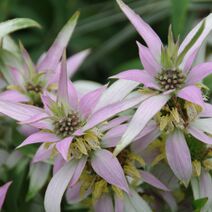Monarda punctata
| Monarda punctata | |
 | |
| Light: | |
| Moisture: | |
| Hardiness: | 6 |
| Soil pH: | 5.6-8.4 |
| Self Pollinated | |
| Height: | 2' |
| Width: | 1' |
| Blooms: | Mid Summer-Early Fall |
| Native to: | |
| Shelter Nectary | |
| Edible Rating: | |
| Medicinal Rating: | |
| Tea: | Yes |
Monarda punctata (common names: horse mint and dotted mint)
An attractant to hummingbirds and bees, the strongly aromatic flower also attract Karner blue—an endangered butterfly species now extinct in Canada. The flowers are self-fertile and self-seed in ideal conditions with full sun and dry soil. Growing in small colonies, space or thin the plants to promote air circulation to protect against powdery mildew and deadhead the blossoms to prolong summer blooms. Edible leaves can be used raw or cooked and make an aromatic tea. This species is distinguishable from others in the genus with multiple flower whorls each stem and cream and purple dotted corollas. What also sets this flower apart from the others is its thymol content, the highest of all mints. Thymol is an antimicrobial compound that has been demonstrated to control varroa mites and to prevent fermentation and mold growth in beehives.
Propagation: Seed - sow mid to late spring in a cold frame. Germination usually takes place within 10 - 40 days at 20°c. When large enough to handle, prick the seedlings out into individual pots and plant them out into their permanent positions in early summer.
The seed can also be sown in situ in late summer in areas where the winters are not too severe and will produce larger plants.
Cuttings of soft basal shoots in spring. Harvest the shoots with plenty of underground stem when they are about 8 - 10cm above the ground. Pot them up into individual pots and keep them in light shade in a cold frame or greenhouse until they are rooting well. Plant them out in the summer.
Division in spring or autumn. Large divisions can be planted out direct into their permanent positions. We have found that it is better to pot up the smaller divisions and grow them on in light shade in a cold frame until they are well established before planting them out in late spring or early summer.
Cultivation: Easily grown in ordinary garden soil so long as it is not too dry[1][2]. Requires a moist soil and a sunny position[2]. This species prefers a light dry alkaline soil[3].
Plants are hardy to about -10°c[4] and should succeed outdoors in most parts of Britain.
A polymorphic species[2].
A good bee plant[2]. Subject to mildew in dry summers[2].
Range: N. America - Louisiana and Florida, north to Long Island.
Habitat: Dry sandy soils in fields on or near to the coastal plain[5][6].
Edibility: Leaves - raw or cooked. A strong aromatic taste, they are used as a flavouring in salads and cooked foods, and also as an aromatic tea[7].
Medicinal: Horse mint was traditionally taken by several native North American Indian tribes to treat nausea and vomiting, and to encourage perspiration during colds. It was also applied externally as a poultice to treat swellings and rheumatic pains[8]. Nowadays it is used primarily to treat digestive and upper respiratory tract problems[8].
The leaves are carminative, diaphoretic, diuretic, emmenagogue, rubefacient, stimulant, stomachic and vesicant[9][10][3]. An infusion of the leaves is used in the treatment of flatulence, nausea, indigestion, catarrh in the upper respiratory tract, and to induce sweating and promote urination[9][8]. The herb is principally used externally as a rubefacient, applied as a poultice it helps to lessen the pain of arthritic joints by increasing the flow of blood in the area and thereby hastening the flushing out of toxins[9][8]. The leaves can be harvested before the plant flowers, or they can be harvested with the flowering stems. They can be used fresh or dried[3].
The plant is a rich source of the medicinal essential oil 'thymol', which is antiseptic[9][11][12]. The plant has been commercially cultivated for its essential oil, though this is now produced synthetically[12]. Thymol is also an effective hookworm remedy, but must be ingested in such large quantities that it can prove fatal to the patient[11].
Usage: The plant has a pleasing aroma and has been hung in the house as an incense[13].
Pollinators: Bees
Soil: Can grow in light, medium, and heavy soils.
Flower Type: Hermaphrodite
Heavy Clay: Grows in heavy-clay soils.
Links
References
- ↑ Chittendon, Fred. RHS Dictionary of Plants. Oxford University Press, 1951.
- ↑ 2.0 2.1 2.2 2.3 2.4 Huxley, Anthony. The New Royal Horticultural Society Dictionary of Gardening. MacMillan Press, 1992.
- ↑ 3.0 3.1 3.2 Bown, Deni. Royal Horticultural Society Encyclopaedia of Herbs and Their Uses. Dorling Kindersley, 1995.
- ↑ Phillips, Roger and Martyn Rix. Conservatory and Indoor Plants Volumes 1 & 2. Pan Books, London, 1998.
- ↑ Lyndon, Merritt. Gray's Manual of Botany. American Book Co, 1950.
- ↑ Britton, Nathaniel and Addison Brown. An Illustrated Flora of the Northern United States and Canada. Dover Publications, 1970.
- ↑ Facciola, Stephen. Cornucopia - A Source Book of Edible Plants. Kampong Publications, 1990.
- ↑ 8.0 8.1 8.2 8.3 Chevallier, Andrew. The Encyclopedia of Medicinal Plants. Dorling Kindersley, 1996.
- ↑ 9.0 9.1 9.2 9.3 Grieve, Margaret. A Modern Herbal. Penguin, 1984.
- ↑ Usher, George. A Dictionary of Plants Used by Man. Constable, 1974.
- ↑ 11.0 11.1 Weiner, Michael. Earth Medicine, Earth Food. Ballantine Books, 1980.
- ↑ 12.0 12.1 Foster, Steven and Billy Tatum. Medicinal Plants of Eastern and Central North America. Houghton Mifflin, 1990.
- ↑ Moerman, Daniel. Native American Ethnobotany. Timber Press, 1998.